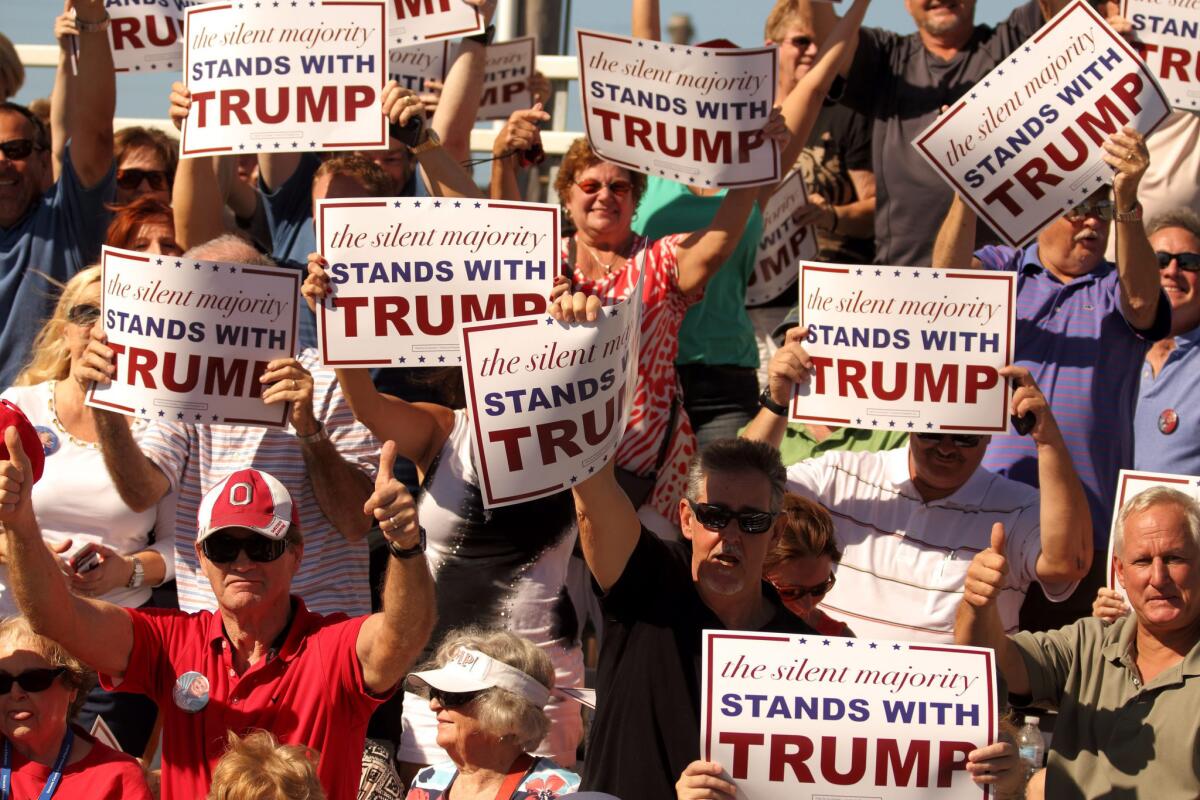Analysis: In 2016, white people must take responsibility for Donald Trump

The crowd at a Donald Trump post-Thanksgiving “Make America Great Again” rally at the Robarts Arena in Sarasota, Fla.
“White people, come get your boy.”
Depending on how you read that line from comedian W. Kamau Bell about Donald Trump, you might take it as a joke. Or you might take offense.
But Bell meant it as a call to action – because Trump is not a Republican problem. He’s a white-people problem.
For the uninitiated, here’s a primer on “getting your boy.” First, you need to tell said “boy” that he is making you look bad in front of polite company. This is a familiar practice to people of color: Whenever a black or brown person does something unsavory in public, members of their community know that it will – fairly or not – reflect on them.
NEWSLETTER: Get the best from our political teams delivered daily
Trump is a particularly embarrassing figure because of whom he purports to represent. His rhetoric might appeal most to white nationalists, including former Ku Klux Klan Grand Wizard David Duke, but his target is not the fringes. Instead, as Duke says, Trump’s campaign is an appeal to “the values and interests of the European-American majority.”
White people should feel insulted by this. They should feel ashamed – as white people – of Donald Trump. Whites need to stand up and say that they will not allow Trump to hijack their culture, or to conduct his racist politics in their name.
Still, that’s not enough.
The second part of “getting your boy” goes beyond distancing yourself from him. A community must take responsibility for any damage that has been done, and take steps to correct it.
White America hasn’t gotten to this step yet – but it needs to, says Tim Wise, a speaker and author who has written extensively on racism. A recent study shows that Trump may actually have more support than previously estimated, but Wise doesn’t think that Trump stands a chance to win the election.
------------
FOR THE RECORD:
An earlier version of this post referred to Tim Wise as David Wise. Also, this article referred to Showing Up for Racial Justice as Standing Up for Racial Justice.
------------
This makes Trump even more dangerous.
“Trump is unleashing this sense among a certain group of white men that violence is acceptable,” he said, referring to recent attacks at Trump rallies. “They’re afraid that their country is being taken away from them by immigrants and people of color, and that Trump is their last chance to take it back. If they discover that they can’t win at the ballot box, the question becomes: What do we expect these angry white people to do?”
“Some of those people,” he says, “might turn to terrorism.”
One sign of a possible shift from anger to action has already emerged: last week, a Richmond, Calif., man was arrested on charges of making explosives with the intent of harming Muslims. A post on his Facebook account said that he would follow Trump “to the end of the world.”
Racism and intolerance have been topics of debate this year, among people of all hues and hashtags. Beginning with the protests in Ferguson in 2014 and throughout 2015, protest movements (though mostly black-led) had a major impact on the national conversation. Black Lives Matter is now a household phrase – in fact, it was even the clue for a “Jeopardy!” question Wednesday night.
Whites, however, have a particular strategic position in the push for social justice, said Kamau Bell in a phone interview with The Times.
“Just being realistic,” he says, “white people listen to other white people better than they listen to anyone else.”
In fact, many whites may not even have anyone else to listen to. “Fully three-quarters of white Americans report that the network of people with whom they discuss important matters is entirely white, with no minority presence,” according to a report by the Public Religion Research Institute.
This phenomenon is underscored in a viral video of a self-described “redneck” named Dixon White. Speaking from his pickup truck, White delivers an impassioned, expletive-laden rant – aimed at other white people. He minces no words: “Let’s take a little bit of white racial responsibility,” he said. “I’m saying we’ve got an evil called white supremacy in this culture.”
“If you hear something racist … stand as a white American, take some … responsibility,” he said.
White’s drawled speech may well have had the effect of throwing some white people off balance just long enough to actually listen to his message.
Conversations about racism in the white community don’t always go so smoothly. Last week, rapper Mac Miller, who is white, posed a challenge to his followers. “Dear White People who listen to rap music,” he asked, “what have you done for the #BlackLivesMatter movement?”
Responses ranged from appreciation to sarcasm. One: “I faved some tweets.”
We should expect some growing pains as this process develops. Mac Miller has had some early trouble galvanizing rap’s white liberal fan base. Even Dixon White came under scrutiny for simply repeating things that people of color had been saying for years. Well-intentioned white liberals are often taken to task for speaking over people of color in conversations about race.
Nonetheless, whites must continue to speak – and listen. Dara Silverman, the national coordinator for Showing Up for Racial Justice (SURJ), says that for white activists, carefully listening to people of color is crucial. SURJ is a national network that encourages white people to “act as part of a multi-racial majority for justice,” and sometimes works in support of groups such as Black Lives Matter.
“We don’t have to be at the center of things,” Silverman said. “But we have the ability to do productive work in our own communities.”
One of the group’s goals for 2016 is to reach out to other largely white groups. “We want to engage a bigger base – churches, unions, environmental groups that are mostly white,” she said. “We can have an impact on elections, on white society in general.”
In order to have that kind of impact, the movement will need numbers – and Silverman has one in mind.
She needs 7 million white people.
According to Silverman, SURJ aims to organize 7 million whites who will pledge to combat racism in their daily lives. That amounts to just above 3.5% of the non-Latino white population of the United States, according to the most recent census projections. That’s her other magic number – according to political scientist Erica Chenoweth, once 3.5% of a population are actively participating in a movement, it can succeed.
There’s a long way to go. The network has grown rapidly over the last year, according to Dinah Ferlito, a Los Angeles-based activist who works with SURJ, but still its database is in the tens of thousands, not millions.
One of the biggest barriers may be apathy. Too many whites are satisfied with things as they are – probably because the system seems to work for them. Even as recently as July, after the protests in Ferguson, Mo., and Baltimore, 40% of whites said in a Pew poll that “our country has made the changes needed to give blacks equal rights with whites.” Some want to take things further. In another poll, taken after Trump suggested banning Muslims from entering the United States, 40% of whites said they would support requiring Muslims to register in a national database.
Even for whites who find Trump’s rhetoric repulsive, joking about him, or even rejecting him, will not be enough. They now need to turn their focus to the society that allowed him to come to prominence. Particularly among whites who prefer to view themselves as “color blind,” there is a dangerous attitude that the best way to make racial injustice go away is to not talk about it.
Join the conversation on Facebook >>
Historically, that has shifted the burden of working for civil rights onto people of color.
As Trump’s rise shows, it is possible for whites to organize around a political and cultural ideal. This year, a community has begun to organize around their whiteness and a desire to return to a (largely fictional) vision of what used to be, to “make America great again.” The challenge now is for whites who care about social justice to create an alternative movement.
They’ll need to vow to work with their neighbors – for many of whom America was never particularly “great” – to make America better.
Follow me @dexdigi for more on the intersection of culture and the Internet.
ALSO
McManus column: Trump, Bush and other things I got wrong in 2015
Caltrans sign in Corona is hacked to show support for Donald Trump
Republican presidential candidates go their own way on climate change despite Paris agreement
More to Read
Get the L.A. Times Politics newsletter
Deeply reported insights into legislation, politics and policy from Sacramento, Washington and beyond. In your inbox three times per week.
You may occasionally receive promotional content from the Los Angeles Times.











